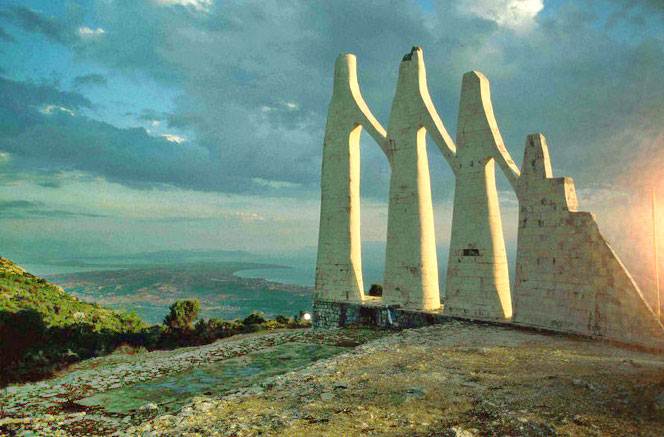One of my favorite tourist sites in Greece is a commemoration of a mass suicide. Not because I’m morbid, but because it’s sublime.
See what I mean?
This is the Monument to the Heroines of Zalongo, a 1954 sculpture by Georgios Zongolopoulos, which captures the vulnerability and wild courage of the Souliot women it represents. In December of 1803, the Souliot people of western Greece were under siege by the forces of Ali Pasha, the Ottoman leader who ruled their area. As the Souliot men lost ground, the women took the children and fled to the hills. Safely ensconced on the top of a mountain, they could view the progress of the scene below, but also had nowhere to go but down.
Eyewitnesses reported having seen several women throw their children from the cliff and then leap off themselves; the bodies of four children were later found below. This horrific event metamorphosed into legend: it was said that the women, knowing they would be taken in slavery if the forces reached them, clasped hands and began to dance in a circle. As each approached the side of the cliff, she threw her child off and jumped to her own death.
Thus was born the Dance of Zalongo, taught to every little Greek girl.
You can see the figures of the monument when you’re still miles away in the valley before beginning your corkscrewy drive up the mountain roads. Huge cut-out paper doll figures, mothers holding hands with their children, facing the canyon before jumping to their deaths. I did not expect to be so moved.
An aesthetically stunning tourist site connected to a powerful narrative is a potent recipe for success. Or so one would think, but the Zalongo monument, tucked away in the formidable hills, feels lonely and neglected. Of greater disappointment to this romantic traveler, who prefers to be alone at ruins and accepts neglect and inconvenience as the trade off, the divine space has been fenced in. And, don’t you know it—bane to tourists everywhere—currently disfigured by scaffolding.
You can no longer walk freely on rocks and grass tufts. Now there’s a large circular stone pavilion laid, like a dance floor, as if we are invited to interact with the monumental women and reenact the dance of freedom for ourselves.




Hi there!
Thanks for your informative post:) I’m considering visiting this site this summer but am having trouble finding information! Can you please help? Did you go from Athens to Souli? Where in Souli is the Dance of Zalongo site? Any info you can share would be greatly appreciated! Thank you!! 🙂
Thank you! The monument’s a little hard to find but is well worth seeking out. I went from Athens to Ioannina, and then drove to the site from Ioannina. You could also easily start from Igoumenitsa or Parga or Preveza, which are all within an hour’s drive of the site. The site isn’t actually in the village of Souli; it is up the mountain from the tiny modern village of Kamarina. Very near the ancient site of Kassopi, which appears on more maps than the Zalongo monument does. From what I understand, the renovations are completed now, so there shouldn’t be any more scaffolding. (I’m hoping so, anyway; I’m going back there myself in June.) Please let me know what you think of it!
Many, many thanks for your informative and useful reply. I sadly never made it there, but I am putting it on my definite to-do list in the future when I get more time to travel. Did you go again?
Thanks for following up on this! I did go again that summer and everything was beautiful: the repairs were finished, the women on the mountain were gleaming. It was still quiet and unvisited when we were there, but we stayed in Parga and I saw signs advertising visits to the monument, so people do go.